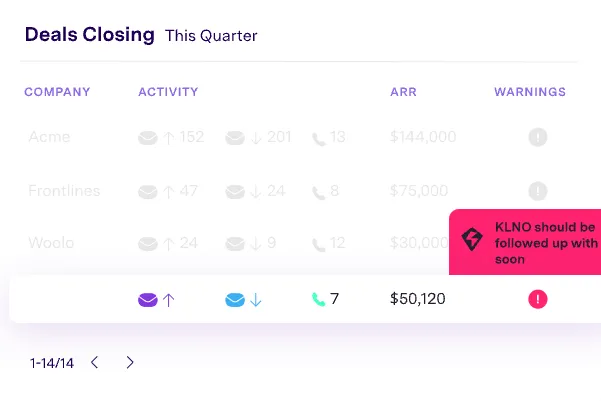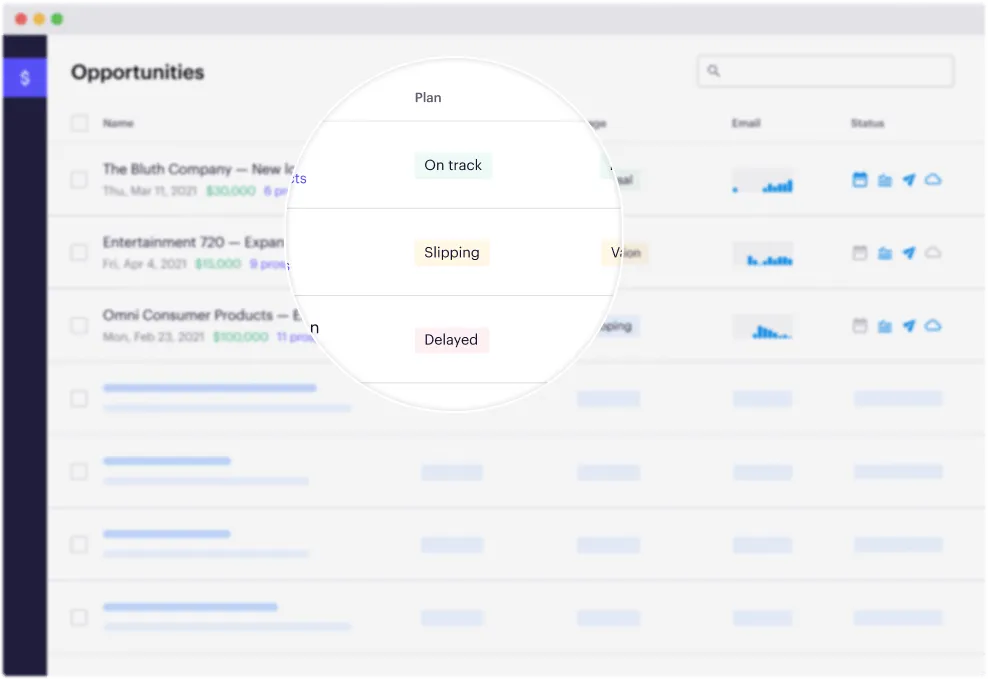
Revenue intelligence may sound like another boring business buzzword. But as your business grows, this can be a big part of your success (or failure).
Think back to the early days of your business. You were in the trenches, working alongside early customers to get real results for them as you grew your own business. You had intimate knowledge of your customers, and keeping track of the sales and revenue growth was easy because there were only ever a few transactions at a time. As the complexities increase, tools like the revenue growth calculator can be instrumental in simplifying the analysis.
Fast forward to today—as your startup or SMB grows, you see how the data starts to become more complex. You’ve got a whole sales team working on closing new customers. All of a sudden, surefire deals are falling through at the last minute. Sales cycles are getting longer. And you’re starting to feel disconnected from your customers.
Sound familiar?
If so, revenue intelligence could be the right solution. Let’s talk about what a revenue intelligence system is, how you can set it up for your business, plus the best revenue intelligence software to get you started.
Want to supercharge your revenue growth? Learn how CRM can help in our article.
What is revenue intelligence & why should you care?
In the early stages of a company, it’s feasible to make decisions and take action based on limited data and gut feeling—in the end, you use what you have available to you.
But as your company grows, it’s absolutely critical for leadership to turn away from gut-based decisions and toward real sales metrics.
The data gathered in a revenue intelligence system includes insights from all points of the sales process, including:
- Visits and interactions on your website
- Engagement with marketing emails or content
- Touchpoints with your sales or support teams during the sales or trial process
- Conversation analytics based on what is said during recorded calls and meetings
- Account-based data
- Information about your competitors
- Predictive data and forecasting based on past deals
Of course, as we’ve always said, too much data can be as of a problem as not enough data. When you’re overwhelmed by data without knowing how to act on it, you’ll enter a state of paralysis that can ultimately kill your startup.
Revenue intelligence solves this problem for sales leaders and business owners by taking the data and turning it into something human beings can understand and act on.
What you can expect from an optimized revenue intelligence process
When you use a revenue intelligence tool and set up your own strategy with it, what changes?
- Your team will spend less time entering data manually: Since data is captured and processed automatically, your sales team can spend more time on what they do best: selling.
- Reps will be able to react faster to early warning signs: Rather than letting gut feeling tell them a deal is doing well, reps will see the data on each deal and can react faster when the data tells them there may be a problem.
- You’ll have up-to-date information you can trust: The goal of revenue intelligence platforms is to give you real-time insights and activity data, meaning you can react immediately to changes and trust that the fast-paced startup world isn’t getting ahead of you.
- Your forecasts will be based on facts, not on your gut: Data gathered from past deals is analyzed constantly using revenue intelligence AI, meaning you’ll have greater insight into what signals a deal is moving forward (or not). With this, you can set forecasts that your team can actually hit.
- All teams will be able to benefit from actionable data: Sales, marketing, customer success, and support don’t have to work in silos. An optimized revenue intelligence system pulls relevant data from all these teams and turns it into insights that everyone can use to better serve your customers.
 |
So, how do you set up your own strategy?
Setting up your own revenue intelligence system: 5 pro tips
When it’s time to set up your own revenue intelligence strategy, here are some key steps you’ll need to take to get started.
1. Understand who on your team will benefit from revenue intelligence, and how they need it to function
Solutions for revenue intelligence run the gamut from extremely expensive and comprehensive to more specific for certain industries or businesses.
Before you jump into a solution, you’ll need to understand:
- Which teams will be contributing data to the revenue intelligence system?
- Who on those teams will be in charge of understanding the data and making decisions on strategy for their team?
- Will this data need to be imported to another system?
In most cases, revenue intelligence is used by sales and revenue leaders. But in a startup, you may also see founders, C-suite executives, and other customer-facing team leaders using revenue and deal data to inform decisions.
2. Identify where your data will come from
Your best revenue intelligence software will depend on the tools that are currently in your sales stack. While many of these platforms integrate with hundreds of other tools, you need to make sure there’s an easy way to link the data between the right tools.
So, make a list of the tools where you’re currently collecting data. First on that list: your CRM.
If you’re using a CRM like Close, essential sales and customer data is stored there automatically, and touchpoints are recorded without manual data entry. But the data in your CRM can be boosted and updated using a revenue intelligence tool, meaning your revenue team will always have the right data at hand.
Other tools might include:
- Website analytics tool
- B2B data provider
- Prospecting tools
- Sales engagement tools
- Sales enablement tools
3. Set clear goals for your revenue intelligence system
If you don’t know what you’re really trying to achieve, it’ll be difficult to measure the results of your revenue intelligence system.
For example, is your team having trouble hitting targets? Are your forecasts for sales and revenue always wrong? Then you could set a goal of increasing quota attainment and hitting forecasts using revenue intelligence data.
Or, what if your sales team is disconnected from customers? Are they losing a higher number of deals further down the funnel? Set the goal of using revenue intelligence insights to improve customer intimacy, lower closed-lost rates in later stages of the pipeline, or shorten your sales cycle.
With clear goals, you’ll know what to expect and where you want to go. Plus, you’ll have a clearer direction for choosing the right revenue intelligence tool.
4. Choose a tool that works for your whole team’s needs
With this prep work in place, it’ll be much easier to decide on the right revenue intelligence platform for your team.
Remember, you need to know:
- Who & how many will be using the platform
- Which tools the platform must integrate with
- Where your main focus will be within the platform
Start by demoing several different platforms. Talk to their sales reps about your specific goals, and let them guide you towards the right solution. Check third-party review sites, or ask around in your network.
Just like when you’re buying a new CRM, it’s much better to do your research and get a clear understanding of what’s out there rather than simply choose the name you recognize off the bat. That way, you’ll make sure you find the right solution for your team, not for every team.
5. Set up a regular cadence of data analysis and decision making
Having the data collected and in place is one thing. Next, you need to make sure you’re using it.
If you don’t have a dedicated revops team or individual, you as a leader need to step up and take responsibility for these insights.
So, take the time to look at these insights. Set a block in your calendar every month or quarter to dig deep into what the AI system has learned about your revenue data.
Then, you can regularly use these insights to:
- Set clear, attainable targets for your team
- Adjust call scripts and email templates to adapt to what customers really care about
- Train and coach your sales reps based on real-time performance
- Adapt how you approach new customers and how your team brings them through the sales process
Compare these 7 revenue intelligence platforms to find the best tool for your team
Find the best revenue intelligence software among these top 7 tools.
1. Gong
 |
Cost: Contact for pricing
Best feature: Early warning signs for deals surfaced automatically
Gong’s revenue intelligence platform is one of the best-known in the industry, with good reason. Its platform has continued to grow over the past few years to include conversational intelligence, deal insights, and performance data for coaching.
Using Gong, you can see where deals are headed, which deals are in danger or stalled, and specific actions your team can take based on what’s worked for them in the past.
2. Clari
 |
Cost: Contact for pricing
Best feature: Bi-directional sync with your CRM, so data is always available and up-to-date
Clari is made for teams that target whole accounts with multiple contacts at a time. It includes intelligent account mapping with touchpoints synced to the right deals, deal inspection, and hundreds of activity integrations to see all the activity your team uses to close deals across the board.
As a total revenue operations platform for enterprise businesses, Clari also includes features such as sales forecasting, pipeline management, deep analytics, and account engagement. In other words, using Clari for revenue intelligence is expensive, but it works.
3. Troops.ai
 |
Cost: Starting at $19/user/month
Best feature: Buyer signals delivered to your team in real-time
Standing at the other end of the spectrum, Troops.ai is a great option for startup sales teams.
This tool links revenue data with your internal messaging tool, like Slack or Teams, and delivers actionable insights to your team where they are.
Although more limited than other tools on this list, Troops.ai is a much more affordable option for SMBs and startups looking for an easy introduction to revenue intelligence.
4. Revenue.io
 |
Cost: Contact for pricing
Best feature: Real-time guidance on sales calls for reps
Leaning heavily into AI, Revenue.io (formerly RingDNA) analyzes every aspect of your sales conversations and touchpoints to deliver the most powerful insights at the exact moment you need them.
It starts by analyzing conversations, performance, and deal status. Then, you get guidance on coaching your team, how to lead conversations, and the next best actions for deals. Finally, Revenue.io gives you multichannel playbooks and prioritization suggestions based on past sales data.
5. Salesforce
 |
Cost: $200/user/month
Best feature: Directly integrated into the Salesforce Sales Cloud
Salesforce has dug into the world of AI for sales, and their Einstein AI also includes revenue intelligence. For teams that are already using Salesforce Sales Cloud, adding revenue intelligence here within the same platform may make sense. (If you’re not already using Salesforce, however, this probably isn’t a good option for your team.)
With the tools here, you’ll be able to see forecasts and analyze performance for your team over time. Plus, you can get insights on where to focus next with tools that show you where to fill the gaps in your quota.
6. Outreach
 |
Cost: Contact for pricing
Best feature: Easy search features to highlight key parts of sales meetings
Clarity is a key part of Outreach’s revenue intelligence platform, enabling reps, leaders, and really the whole team to track the progress of deals and understand what should be coming next.
Outreach uses both AI and machine learning to understand what’s happening in your pipeline, alerting you to deals that may be on the edge of extinction. Reps also have an AI virtual assistant in their calls who uses NLP to understand key points of the call and provide reps with the right resources and answers to questions.
7. InsightSquared
 |
Cost: Contact for pricing
Best feature: Pre-made reports and dashboards built for revops teams
With AI-powered activity capture and sales forecasting, InsightSquared is another top revenue intelligence platform for sales teams, especially if you’re using Salesforce. It includes guided selling prompts, conversation intelligence, dashboards for different user types, and interactive reporting.
Turn revenue intelligence data into more closed deals
For sales teams that need better visibility, a more intimate understanding of their customers, and improved sales forecasts, revenue intelligence is a good place to start.
Remember: having data to make decisions is helpful, but too much data can be overwhelming. Before diving into revenue intelligence, make sure you’ve got basic sales analysis under control. Then you can feel more confident moving onto the big guns.
With the right strategy and tools, you’ll be able to turn that revenue intelligence data into more deals and happier customers.
Want to learn more about startup sales? Get the playbook from yours truly, taken from my own experiences helping thousands of founders navigate the world of startup sales:










